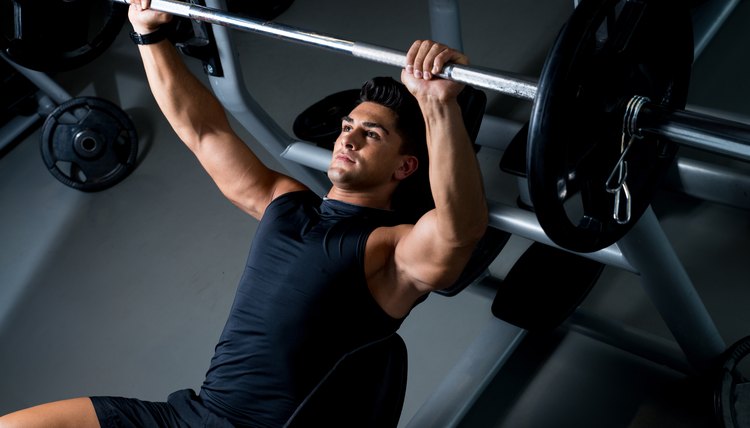How Long Will It Take Me to Have a Muscular Chest?

Men and Women can develop their chest muscles by following an appropriate weight lifting program, but the time it takes to see significant increases is likely to vary. There are factors that will dictate how long it takes to build strength and create muscle growth in the pectoralis major and pectoralis minor, also known as the pecs, including how frequently you train, the volume of your workouts and some genetic factors.
How to build chest muscles?

Visage/Stockbyte/Getty Images
It can take up to eight weeks of weight-training to see significant improvements in muscle size. To get a significantly bigger chest in two months, you must train aggressively. If you are new to exercise, you are likely to see quicker results than bodybuilding regulars who exercise regularly and already have a significant amount of muscle development.
How to develop your Chest?
In order to build your chest muscles as quickly as possible, you should participate in a strength training program designed specifically for that purpose. Weight train two to three days per week on nonconsecutive days and complete at least eight total sets of chest workouts during each full body workout . This means, for example, you could choose two chest exercises and complete four sets of each, or choose four chest exercises and complete two sets of each. Perform eight to 20 reps, or repetitions, in each set, resting one to three minutes in between. Some choose to do a dedicated chest day or split workouts to gain muscle, but it's up to personal preference.
What are some good chest exercises?
There are a variety of chest exercises you can use in your workout routine. Chromiak suggests changing up the exercises regularly in order to better create activation in your chest muscle groups and prevent them from hitting a plateau. Exercises that are effective at creating hypertrophy in your chest include dumbbell bench press, barbell bench press, incline chest press, dumbbell flyes, deadlift, and alternating chest press on a flat bench. You can utilize bodyweight exercises like push-ups, decline push-ups, and dips if you don’t have a gym at home.
Warm Up and Stretch
Warmup exercises help prevent injuries by increasing the elasticity of your muscle fibers and lubricating your joints. Perform light- to-moderate intensity aerobics or calisthenics for five to 10 minutes before you work out with heavy weights. Do stretches after your workout to build up your flexibility and reduce muscle soreness. Reach for the ceiling with interlaced fingers, palms facing upward for an upper-body stretch. Drop one arm behind your upper back and press your hand on the opposite side against the elbow of your dropped arm to increase the stretch. Repeat on the other side. Bring one arm across your body at chest height and press against the forearm with your opposite hand. Repeat on the opposite side.
Warnings
Before beginning a muscle building workout plan for your pectorals, consult a physician or personal trainer. Also consult a physician before taking supplements or starting a diet to build muscle mass.
Explore In Depth
Writer Bio
Kim Nunley has been screenwriting and working as an online health and fitness writer since 2005. She’s had multiple short screenplays produced and her feature scripts have placed at the Austin Film Festival. Prior to writing full-time, she worked as a strength coach, athletic coach and college instructor. She holds a master's degree in kinesiology from California State University, Fullerton.
